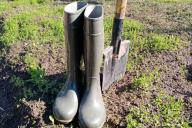Flower growers pay attention to pelargoniums in February-March, and in summer they enjoy their gorgeous flowering.
At the end of winter and the beginning of spring, plants need to be pruned, replanted and fed.
Trimming
If autumn pruning was not carried out, then within a few months the pelargonium will stretch out considerably.
Care of the bushes begins with the removal of all internal woody thickening shoots. Along with them, rotten or damaged branches are removed.
The procedure promotes the growth of young shoots and improves ventilation of the bushes.

Transfer
Time passes, so it is not surprising that the cutting has turned into a strong and healthy plant that requires a larger pot. Transplanting of grown flowers is carried out no earlier than the root collar is exposed or the roots grow strongly.
The new container should be larger than the previous pot by the thickness of one finger. Pelargonium does not like large flowerpots. Otherwise, the plant will direct all its resources to the growth of green mass and roots, and not to the formation of inflorescences.
Top dressing
In March and until flowering, complex fertilizers are applied once every 14 days, using liquid fertilizers that contain approximately the same amount of nitrogen, potassium and phosphorus. During flowering, the amount of fertilizers is reduced by half. But you can slightly increase the amount of potassium.








